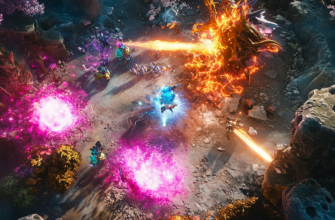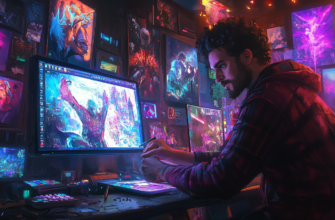- How the COVID-19 pandemic permanently reshaped the world of gaming
- 1. Social gaming: remote and connected communities
- Changes in multiplayer game design
- 2. E-sports and streaming exploded
- Impact of COVID-19 on popularity of e-sports
- 3. Increased demand for hardware…but shortages hit hard
- Why we’ll still see hardware scarcity impacts in the future
- 4. Rise of indie games
- Why indie games gained popularity post-pandemic
- 5. The shift toward digital and cloud-based gaming
- Examples of popular cloud gaming services
- Conclusion: What’s next for gaming post-pandemic?
How the COVID-19 pandemic permanently reshaped the world of gaming
Hey, bro! Let’s take a minute to talk about how much gaming has changed over the last couple of years. If you’re like me and spent most of your downtime during the COVID-19 pandemic glued to a screen playing games, you’ve probably noticed that gaming went through some real transformations. Unexpected challenges like lockdowns and social distancing kind of forced everyone—gamers, developers, and publishers—to adapt. Games weren’t spared from the effects of the pandemic, and some big, lasting changes took place.
So, how exactly did games evolve in the post-pandemic era? And what does this mean for us as PC gamers? Today, I’m diving into that topic. Let’s explore the major shifts that will continue to influence everything from the way we play games, to the games we choose, to the hardware we game with. Let’s check ’em out together and see just what’s changed.
1. Social gaming: remote and connected communities
Before the pandemic, gaming was already becoming more social, but then COVID-19 hit, and suddenly, gaming was THE way to hang out with friends and even meet new people. With physical distancing rules in place, we couldn’t easily meet up in person. So, what did a lot of us do instead? We turned to online multiplayer titles like Fortnite, Among Us, and Call of Duty: Warzone to fill that void.
Gaming went from being something you did solo or with a few friends to one of the most popular social activities available. Even games that weren’t multiplayer saw increased in-game communities or co-op features expand to help people stay connected. Discord servers blew up too, becoming a digital substitute for face-to-face interaction. More importantly, this shift towards social online experiences hasn’t just stayed a “pandemic thing.” It stuck, and now, gaming is one of the main platforms for socializing in large, digital communities.
Changes in multiplayer game design
- Games began emphasizing co-op modes or bigger multiplayer lobbies during 2020, and that’s not going away. Expect more titles where teamwork and communication are key.
- Cross-play integration has become a standard feature, allowing friends to connect no matter which platform they’re gaming from—whether it’s PC, consoles, or mobile devices.
2. E-sports and streaming exploded
Watching e-sports tournaments and game streams has been popular for years, but during the pandemic, they reached whole new levels. With traditional sporting events canceled or postponed, people turned to e-sports as the next best thing. Big players like League of Legends, Dota 2, and CS:GO saw even more attention. Viewership went up, participation increased, and of course, we all started streaming more.
For individual streamers, sites like Twitch and YouTube Gaming experienced massive surges in traffic. Everyone was stuck at home, looking for someone to stream to or watch. Following the pandemic, many casual gamers have become content creators themselves, with some even making a career of it.
Impact of COVID-19 on popularity of e-sports
- E-sports became mainstream during the pandemic, and many event organizers shifted to virtual tournaments. Even championships that were previously in-person shifted to remote setups.
- This trend of expanding tournaments and audience engagement online continues post-pandemic, rather than reverting to physical-only tournaments.
If you’re into streaming yourself or want to get started, now’s one of the best times. Platforms offer more tailored features than ever to boost your success.
3. Increased demand for hardware…but shortages hit hard
OK, let’s talk about something pretty much all of us experienced: hardware shortages. Scalpers, production delays, and an insane increase in demand made it tough to get GPUs, gaming laptops, next-gen consoles, or even decent webcams for a time. As everyone started gaming a lot more, demand for hardware reached all-time highs. This was pretty ironic because, on the one hand, the increased demand made gaming even more popular, but then in turn, trying to upgrade your PC for all those new releases became almost impossible.
If your inbox was full of notifications about restocks that sold out in minutes, you know exactly what I’m talking about. GPUs practically became currency!
Why we’ll still see hardware scarcity impacts in the future
- The global semiconductor shortage, caused by supply chain issues during the pandemic, left a lasting impact. While we’re moving toward recovery, demand for hardware is still up, which means prices and availability will probably be a tough balancing act for a while yet.
- For many, cloud gaming like GeForce NOW or Xbox Cloud Gaming has become a viable alternative to upgrading expensive hardware. These services reduce the hardware burden on the user, making high-performance gaming more accessible.
4. Rise of indie games
Don’t get me wrong, I love AAA games. But something about indie titles has gotten even cooler since COVID-19 hit. The pandemic forced developers to adopt remote work setups, and surprisingly, some smaller studios absolutely killed it. Indie games thrived, whether because they could adapt faster to challenges, or because players just wanted fresh, unique content during a time when bigger studios faced delays and production hurdles. Some of my favorite pandemic-era hits were indie games like Hades, Spiritfarer, and Phasmophobia.
Additionally, digital distribution platforms like Steam and Epic Games Store drove even more exposure to indie games that may have flown under the radar pre-pandemic. And let’s be real—when you’ve played through all the major AAA releases, sometimes all you want is something unconventional or different.
Why indie games gained popularity post-pandemic
- Indie developers are generally more flexible. Operating remotely and working with smaller teams helped them innovate and adapt faster than major studios, even during pandemic uncertainty.
- Players, stuck indoors, started digging for hidden gems and became more open to titles they might not have considered pre-pandemic.
5. The shift toward digital and cloud-based gaming
Physical copies of games are slowly becoming relics of the past, and the pandemic gave that trend a serious push. Lockdowns made it harder to get to brick-and-mortar stores, and digital sales skyrocketed. Nearly all of us turned to digital platforms to snag our favorite titles. I think a lot of players and developers realized how convenient digital games can be—no more running out to buy disks or waiting on shipping.
On top of that, cloud gaming services—where you stream your games rather than downloading them—became even more attractive. Laptops, low-tier PCs, or even phones could now become gaming devices with the power of the cloud. I expect this trend to keep growing. It’s great for anyone who can’t afford the latest and greatest hardware, yet still wants to play AAA games at high quality.
Examples of popular cloud gaming services
- NVIDIA GeForce NOW: A streaming service that lets you play high-end PC games on various devices via the cloud.
- Google Stadia: While officially winding down, Stadia set the stage for ambitious cloud gaming initiatives.
- Xbox Cloud Gaming: Fulfill your Xbox ecosystem dreams by playing on a PC or mobile device.
Conclusion: What’s next for gaming post-pandemic?
The COVID-19 pandemic profoundly changed the gaming world, and even though it presented huge challenges—like production delays and hardware shortages—it resulted in some incredible shifts. Gaming communities got bigger and stronger globally, e-sports entered the mainstream spotlight, indie developers received more love, and cloud-based gaming leveled up accessibility.
As we move into the years ahead, these trends will continue to shape how we play, stream, and connect around games. So, whether you’re diving into your next online multiplayer, checking out a new indie release, or upgrading your cloud gaming setup, the future looks bright for gamers.
Bro, I highly recommend catching up on some of the trends I’ve mentioned if you’re looking to level up your gaming experience or expand your horizons. Got a story of how your habits or favorite games changed post-pandemic? Drop a comment! Let’s keep the discussion going.

















